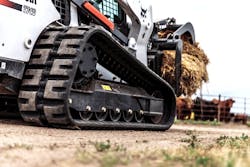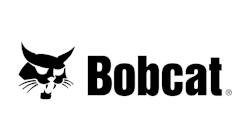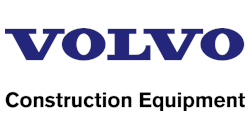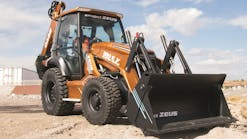Editor’s note: This article first appeared in the January/February 2010 edition of Grading & Excavation Contractor.
The skid-steer tracks versus tires debate continues. While many manufacturers believe there is no definitive deciding line on the better machine, every single one of them has an opinion about which to use where and when—and if one machine can be configured to do the work of both.
Since its inception roughly 40 years ago, the skid-steer has risen to become the largest single selling piece of equipment in the construction industry. This versatile workhorse is considered an industry staple, relied upon by virtually all contractors and included in fleets sized small to large. But in recent years, it has faced some tough competition from the increasingly popular compact track loader (CTL). Despite the added expense, tracks are establishing a new trend with contractors.
Caterpillar acknowledges that skid-steer loaders (SSLs) are the lowest operating cost solution where approximately 85% of the operating cost, excluding the operator, comprises fuel and tires. Skid-steers excel in applications where the ground conditions are firm and higher travel speed is required. An SSL weighs less than a track unit, allowing for more flexibility to transport. According to Caterpillar, an SSL also requires the lowest amount of maintenance to minimize the O&O cost.
It’s important to match the right machine to the job duties, site conditions, and geological area. Because there are so many options, choosing the right machine can be a confusing decision. In order to make the right selection, the contractor needs to know the jobsite application, advises Bob Beesley, product manager for Komatsu in Newberry, SC. The problem is, he admits, no two sites are alike, so it gets complicated.
The general consensus maintains that skid-steers work best on paved or hard surfaces, landscaped areas, or concrete, while the CTL excels in loose, wet, muddy, snowy, sloppy conditions and on slopes and uneven terrain. “While uneven terrain, slopes, and muddy or snowy ground conditions can be very challenging and tough on skid-steer loaders, compact track loaders are designed and built to handle these types of conditions,” states Rick Harris, senior product manager, Terex Construction.
Ground conditions are often closely related to geological areas. Because rocky and abrasive conditions cause excessive wear, Mike Fitzgerald, product specialist for Bobcat, indicates that “a skid-steer may be the most cost-effective choice for those locations, which are typical in the Southwest and mountainous regions.” For wet or sandy conditions common in Florida or many northern regions of the continent, a compact track loader will perform better.
Tracking the Benefits
The compact track loader was created in an attempt to increase the versatility of the skid-steer, claims Mike Murphy, global product marketing for manager dozers and wheel loaders with New Holland in Carol Stream, IL, because it can “operate in worse underfoot conditions, flotation, softer, wetter conditions.” Supporting that idea, David Steger, national product and training manager for Takeuchi in Pendergrass, GA, sees the CTL replacing the skid-steer because it’s more versatile in wet conditions. In fact, Chris Giorgianni, general manager product marketing for JCB, says the CTL now comprises 30% of the market.
Because compact track loaders use the same attachments (buckets, dozer blades, mulchers, augers, trenchers, levelers, box rakes, snow blowers, etc.) and perform in the same applications as skid-steers (construction, landscaping, rental, forestry, and agricultural applications), Harris considers the most distinct advantage of a CTL its superior maneuverability in adverse ground conditions. “CTLs provide exceptional operation in muddy or snowy conditions where skid-steers would not be able to work at all.”
Approximately 95% of the operating cost of a tracked machine, excluding the operator, comprises fuel and undercarriage. A track unit will require a higher level of maintenance in order to minimize the O&O cost of the unit. Track units excel in applications where ground conditions require the highest level of traction and flotation while providing minimal ground disturbance. This extends a customer’s working season by providing a machine that can work even when an SSL can’t. Track units also provide higher operating capacity versus comparably sized wheel units due to their more stable footprint. Caterpillar track units also provide the benefit of a suspended undercarriage. This provides better traction in uneven terrain while providing a more comfortable ride for the operator.
The CTL’s flotation allows it to work in areas wheels can’t go, such as wet or muddy soil. Beesley relates a tale of driving a Komatsu track loader into soft ground conditions, climbing out and sinking to his knees just in front of the machine, still perched on top of the much. That kind of flotation means that even on dry soil, the ground isn’t disturbed. “It doesn’t make ruts like wheeled machines, and it can get into areas inaccessible to a skid-steer.” Because there’s less ground disturbance, there’s also less ground repair and cleanup, so crews can get off the site more quickly.
They can also get in sooner. As Harris notes, “Waiting for the job site to dry out after a rain day means wasted productivity time.” Compact track loaders are designed and built to handle wet, soft, sensitive, or muddy conditions. They exert low ground pressure on a surface, so there’s less damage to pre-existing grounds, even after rain. “This means you’ll have a longer, less interrupted working season.”
This article is continued in Part 2: Wheels vs. Tracks: The Debate Over Compact Loaders. This article was originally posted in 2011.









